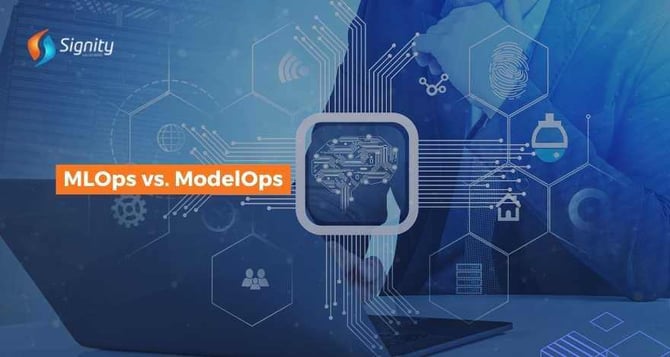MLOps vs. ModelOps: What’s the Difference?
MLOps and ModelOps are used for various purposes in businesses across all industries. Explore the difference between MLOps and ModelOps, when to use MLOps vs. ModelOps, and how companies can implement MLOps and ModelOps for better growth.

With the technology advancing every day, the use cases of Generative AI and ML can be seen across businesses of all sizes. From predictive maintenance to fraud detection, personalized recommendations, and supply chain optimization, AI and ML models have helped save time by eliminating manual work.
In this tech-leading world, MLOps and ModelOps are often used interchangeably, whereas these two have different use cases and lend distinct benefits to the business.
This blog focuses on listing the differences between these technologies and how companies can use these in their operations. Explore how ModelOps and MLOps services can help automate various tasks to boost productivity.
Firstly, let's take a quick look at what exactly these technologies are, along with their crucial components.
Key Takeaways
- MLOps focuses on streamlining ML model deployment and maintenance.
- ModelOps manages diverse models with a focus on governance and compliance.
- MLOps is used by data scientists and ML engineers; ModelOps by risk, IT, and business teams.
- MLOps tools include TensorFlow Extended and MLflow; ModelOps tools include ModelDB and ModelOp Center.
MLOps vs. ModelOps- Definition and Key Components
As mentioned above, though MLOps and ModelOps terms are sometimes confused but, each has its own role.
What is MLOps?
MLOps is the practice of combining machine learning and operations to streamline the deployment and maintenance of ML models across the organization's infrastructure. It aims to bridge the gap between data science and IT operations to ensure smooth, reliable, and scalable model deployment.
Key Components of Machine Learning Operations
- Experiment Tracking: Integration with version control, notebook environments, and capabilities to track data, hyperparameters, and evaluation metrics.
- Data Processing: Data connectors, encoders/decoders, transformation and feature engineering, and scalable batch/streaming data processing.
- Model Training: Environment provisioning, distributed training, and hyperparameter tuning.
- Model Evaluation: Performance evaluation, comparison, and interpretation of model outputs.
- Model Serving: Low-latency inference, auto-scaling, and logging of requests/results.
- Online Experimentation: Canary/shadow deployments, A/B testing, and multi-armed bandit capabilities.
- Model Monitoring: Detection of performance degradation and need for updates.
What is ModelOps?
ModelOps refers to the set of practices and processes designed to operationalize and manage machine learning models, ensuring their efficiency, accuracy, and reliability throughout their lifecycle in production environments. It involves the collaboration between data science and operations teams to monitor, update, and govern models effectively.
Key Components of ModelOps:
- Model Lifecycle Management: Versioning, testing, deployment, and monitoring of models across the organization.
- Model Deployment Automation: Streamlining the process of deploying models to production environments.
- Model Performance Monitoring: Continuous tracking and analysis of model performance in production.
- Model Retraining and Updating: Automating the process of retraining and updating models based on new data or changing business needs.
- Model Governance: Ensuring models are developed and deployed according to industry standards and regulatory requirements.
- Model Collaboration and Sharing: Enabling multiple teams to work on and share models across the organization.
- Model Inventory and Catalog: Maintaining a centralized repository of all models deployed across the enterprise.
Now that you know the basics of these two technologies, the next section provides a quick look at the differences.
Machine Learning Operations vs. Model Operations- A Quick Comparison
Before diving deep into the differences, here is a quick comparison of machine learning models and model operations.
|
Aspect |
MLOps |
ModelOps |
|
Focus |
MLOps focuses on operationalizing machine learning models. |
ModelOps focuses on operationalizing models like ML, statistical, predictive, and rule-based models. |
|
Scope |
MLOps focuses on the technical aspects of deploying and managing ML models in production. |
On the other hand, ModelOps has a broader focus on the entire lifecycle from development to deployment. |
|
Primary Users |
Its primary users include data scientists and MLOps engineers. |
Its primary users include enterprise risk, IT, and business operations teams. |
|
Key Capabilities |
|
|
|
Flexibility |
It is more prescriptive in terms of tools and technologies used. |
It provides more flexibility for building and deploying models on different platforms. |
|
Skill Sets |
MLOps requires more specialized skills in areas like deployment automation and containerization. |
ModelOps requires skills like data science, software engineering, DevOps, and business analysis. |
Let's dive deep into the differences between machine learning operations and model operations.
MLOps vs. ModelOps Use Cases
Another major comparison between MLOps and ModelOps can be seen in their use cases.
MLOps Use Cases:
- Predictive Maintenance: MLOps are employed to deploy ML models that can predict equipment failures and enable timely maintenance to reduce downtime.
- Fraud Detection: The FinTech industry uses ML systems to analyze transaction patterns and identify any suspicious activities in real time.
- Personalized Recommendations: Industries like eCommerce and streaming services leverage the power of MLOps tools to update recommendation engines that provide personalized product or content suggestions.
- Customer Segmentation: The marketing team uses MLOps to deploy models for segmenting customers based on behavior, demographics, and preferences to build marketing strategies.
- Demand Forecasting: Retailers and the manufacturing industry leverage the power of MLOps by deploying models to predict demand trends for optimizing inventory levels and reducing stockouts.
ModelOps Use Cases:
- Risk Management: Financial and insurance companies use ModelOps to manage and deploy a variety of models that assess and mitigate risks.
- Regulatory Compliance: Organizations in regulated industries use ModelOps to ensure that their models comply with industry standards and regulatory requirements.
- Operational Efficiency: Companies use ModelOps to deploy and monitor models that optimize supply chain operations, manage inventory, and forecast demand.
- Credit Scoring: Financial institutions use ModelOps to deploy and manage credit scoring models that assess the creditworthiness of loan applicants.
- Healthcare Diagnostics: Healthcare providers use ModelOps to deploy and manage models that assist in diagnosing diseases, ensuring accuracy and reliability in patient care.
MLOps vs. ModelOps- When to Choose What Technology
As both these technologies have different uses, it is important to understand when businesses should choose which technology to gain the best benefits.
When to Choose MLOps:
- Focus on Machine Learning Models: If your primary need is to operationalize machine learning models specifically, MLOps is tailored for this purpose.
- Need for Technical Integration: If seamless integration with data science platforms and technical environments is crucial, MLOps provides the necessary frameworks.
- Data Science-Centric: If your team primarily consists of data scientists and MLOps engineers, this approach will align well with their expertise.
When to Choose ModelOps:
- Diverse Model Types: If your organization uses a variety of models (ML, statistical, predictive, rule-based), ModelOps offers a holistic approach.
- Regulatory and Compliance Needs: If adherence to industry standards and regulatory requirements is critical, ModelOps ensures robust governance.
- Enterprise-Wide Collaboration: If your operations require extensive collaboration between data science, IT, and business teams, ModelOps facilitates this interaction.
MLOps vs. ModelOps: Tools and Technologies
Another major difference between these two technologies is the technologies and tools used for operations. MLOps primarily focuses on the technical aspects of deploying ML models, and ModelOps emphasizes governance, compliance, and managing a diverse set of models.
MLOps Tooling and Technologies:
- MLOps tools include TensorFlow Extended (TFX), MLflow, and Kubeflow.
- MLOps platform is used for integration with CI/CD tools such as Jenkins, GitLab, or GitHub Actions.
- It uses containerization technologies like Docker and orchestration like Kubernetes.
ModelOps Tooling and Technologies:
- ModelOps tools include ModelDB, Seldon, and Algorithmia.
- The ModelOps platform, like the ModelOp Center, is used for model governance and compliance.
- It is an enterprise-wide model management tool for cataloging and tracking models.
Want to Transform Your Data Strategy with ModelOps?
Elevate your model lifecycle management with our expert ModelOps services, ensuring scalability and reliability.
Work With AI Model Experts at Signity Solutions
Now that you know how MLOps and ModelOps differ from each other and their use cases, you need a team of AI model experts who can help implement the best practices.
Our data scientists and software engineers are trained to work with the MLOps platform and ModelOps platform using the latest tech stack, like large language models and generative AI.
Get in touch with our professionals and get the right guidance for implementing MLOps and ModelOps. Book your consultation today.
Frequently Asked Questions
Have a question in mind? We are here to answer. If you don’t see your question here, drop us a line at our contact page.
What is the difference between ML and MLOps?
![]()
ML engineers focus on creating and training models, while MLOps deploys models in production and ensures their reliability.
What is the primary focus of MLOps compared to ModelOps?
![]()
MLOps focuses on operationalizing machine learning models for seamless deployment, monitoring, and maintenance. On the other hand, ModelOps encompasses the entire lifecycle of these models, from development to deployment and governance.
What are the key components of MLOps?
![]()
Key components of machine learning operations include experiment tracking, data processing, model training, model evaluation, model serving, and model monitoring.
What are the key components of ModelOps?
![]()
Key components of ModelOps include:
- Model lifecycle management.
- Model deployment automation.
- Model performance monitoring.
- Model retraining.
- Model governance.
- Model inventory and catalog.
What types of tools and technologies are commonly used in MLOps and ModelOps?
![]()
Tools and tech for MLOps include TensorFlow Extended (TFX), MLflow, and Kubeflow. Tech for ModelOps include ModelDB, Seldon, and Algorithmia.



.png?width=344&height=101&name=Mask%20group%20(5).png)

















